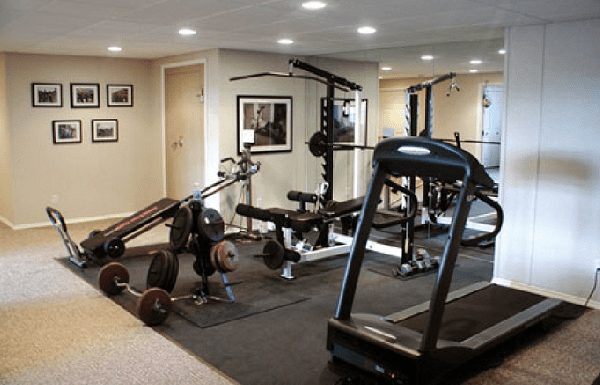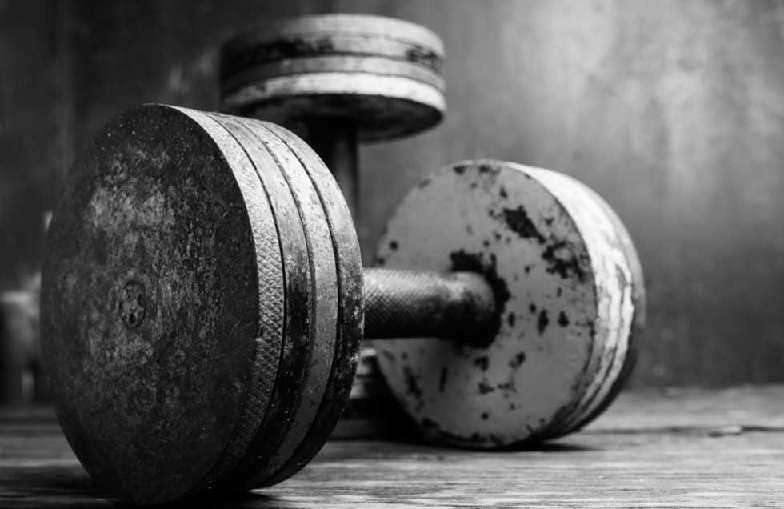
You can train in one of two places: in your home or at a fitness facility. The following section discusses the pros and cons of each option.
For many people, training at home is the only practical option because of time constraints, membership cost at a fitness facility, or both. Many people simply prefer to train in their own homes. If you want to train at home, you need to consider several basic equipment and space issues.
When selecting a place to train at home, begin by determining a suitable area for storing equipment as well as working out. The location should be out of the way of the main travel routes in your home. It should be well ventilated and well lit, and it needs at least one electrical outlet. It should also be securable if you have young children or pets. An electrical outlet offers the opportunity to plug in an mp3 player, radio, or maybe a treadmill or stair-stepping machine. If you have a choice, select an area that has a high ceiling.
The floor of a home facility is commonly carpet-covered concrete. Such a surface is better than tile or uncovered concrete because both can be slippery and easily damaged from dropping barbells and dumbbells or moving equipment. Also, arrange the tallest pieces of equipment next to the walls, but allow at least a 6-inch (15 cm) space. If you have more than one machine or bench, give yourself at least 18 inches (46 cm) between them for easy access.

The minimum amount and type of equipment you need to use when following a basic weight program consists of a standard barbell with collars and locks, a set of adjustable dumbbells, 80 pounds (36 kg) of standard weight plates, and a bench with upright racks long enough so that you can
lie down with both your head and buttocks squarely on the pad. If you are well trained—or plan to be in the future—you may need to buy an additional 135 pounds (61 kg) of standard weight plates. If the cost of equipment is a concern, resistance band training is also an option.
For more serious lifters, the Mayo Clinic recommends that basic equipment needs include an Olympic bar and locks, a set of dumbbells (in 5-pound increments, possibly up to 50 pounds or more), 255 pounds (or about 120 kg) of Olympic weight plates, and a bench with upright racks to hold an Olympic bar. You may also want to buy a squat rack so that you do not have to pick up the barbell from the floor to do squats or standing shoulder presses. To hold all the weight plates, consider buying a weight tree so that the plates are not in piles on the floor.
Selecting a fitness facility that will meet your needs is a challenge. If you need the expertise of a qualified personal trainer to help you get started, that should be the first priority when selecting where you will work out. Ideally, the facility you choose will have both qualified personnel and a variety of equipment and programs to meet your training needs.
A well-qualified personal trainer who understands how to motivate you can make every training day an enjoyable and rewarding experience. A truly qualified personal trainer has a college degree in exercise science (or a similar area) and has earned one or more certifications in personal training, health, or fitness from a respected professional organization.
Obtain a referral from people you trust—or at least observe the personal trainer in action before making a decision. How well a personal trainer is able to make technical information understandable is essential to your success.
A good personal trainer will help you understand what you are doing and why you are doing it. In addition, it never hurts to work with someone who has a motivating personality that will energize you to stick to your training program.
If you are new to weight training and decide to train on your own in a fitness facility, one of your first decisions concerns whether to use weight machines or free weights. Although free weights offer you the tremendous versatility of choosing among many possible exercises, they require more skill. Although machines are not foolproof, they are generally easier and safer once you learn how to use them properly.
Take special care when selecting loads because sometimes even the lightest weight plate on the machine or bar may exceed your strength in a particular exercise. Also, keep in mind that the dimensions of some machines may not accommodate your physique, especially if you are short, tall, or very heavy. For those reasons, it is wise to receive instruction from a qualified professional for at least the first couple of sessions because he or she can teach you how to perform the exercise and how to make necessary machine adjustments. If you decide to use free weights, obtaining professional instruction is even more important.
There’s so much good, reasonably priced work out equipment for the home that there’s something for everyone. That takes care of the “I don’t have time” excuse, as the equipment is always accessible and ready for a short, or long, workout.
Encourage older people to get involved with weight training. It’s usually written off for the elderly, but maintaining muscle mass to support the bones is very helpful in general health and avoiding falls in particular.
Getting a good personal trainer is a great help like the article says. But, uhm, how many people can afford that?
Having equipment at home is of great help – you can always find time to squeeze in a few minutes to work out. The problem is that for many people, they need to be around other people working out in order to get motivated. That type of person really needs a gym in order to work out consistently.